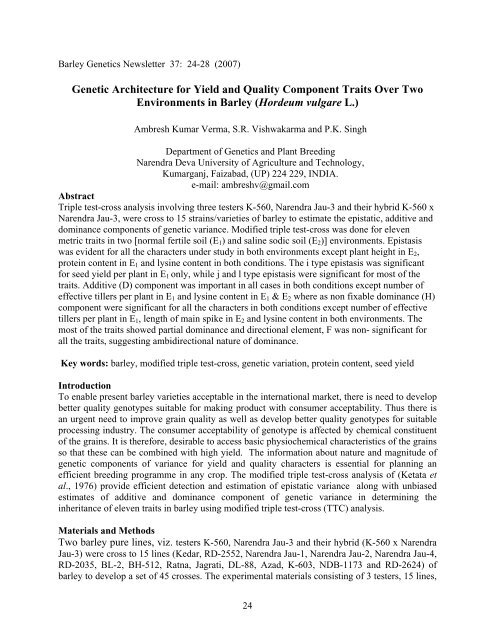BARLEY GENETICS NEWSLETTER - GrainGenes - US Department ...
BARLEY GENETICS NEWSLETTER - GrainGenes - US Department ...
BARLEY GENETICS NEWSLETTER - GrainGenes - US Department ...
You also want an ePaper? Increase the reach of your titles
YUMPU automatically turns print PDFs into web optimized ePapers that Google loves.
Barley Genetics Newsletter 37: 24-28 (2007)<br />
Genetic Architecture for Yield and Quality Component Traits Over Two<br />
Environments in Barley (Hordeum vulgare L.)<br />
Ambresh Kumar Verma, S.R. Vishwakarma and P.K. Singh<br />
<strong>Department</strong> of Genetics and Plant Breeding<br />
Narendra Deva University of Agriculture and Technology,<br />
Kumarganj, Faizabad, (UP) 224 229, INDIA.<br />
e-mail: ambreshv@gmail.com<br />
Abstract<br />
Triple test-cross analysis involving three testers K-560, Narendra Jau-3 and their hybrid K-560 x<br />
Narendra Jau-3, were cross to 15 strains/varieties of barley to estimate the epistatic, additive and<br />
dominance components of genetic variance. Modified triple test-cross was done for eleven<br />
metric traits in two [normal fertile soil (E1) and saline sodic soil (E2)] environments. Epistasis<br />
was evident for all the characters under study in both environments except plant height in E2,<br />
protein content in E1 and lysine content in both conditions. The i type epistasis was significant<br />
for seed yield per plant in E1 only, while j and l type epistasis were significant for most of the<br />
traits. Additive (D) component was important in all cases in both conditions except number of<br />
effective tillers per plant in E1 and lysine content in E1 & E2 where as non fixable dominance (H)<br />
component were significant for all the characters in both conditions except number of effective<br />
tillers per plant in E1, length of main spike in E2 and lysine content in both environments. The<br />
most of the traits showed partial dominance and directional element, F was non- significant for<br />
all the traits, suggesting ambidirectional nature of dominance.<br />
Key words: barley, modified triple test-cross, genetic variation, protein content, seed yield<br />
Introduction<br />
To enable present barley varieties acceptable in the international market, there is need to develop<br />
better quality genotypes suitable for making product with consumer acceptability. Thus there is<br />
an urgent need to improve grain quality as well as develop better quality genotypes for suitable<br />
processing industry. The consumer acceptability of genotype is affected by chemical constituent<br />
of the grains. It is therefore, desirable to access basic physiochemical characteristics of the grains<br />
so that these can be combined with high yield. The information about nature and magnitude of<br />
genetic components of variance for yield and quality characters is essential for planning an<br />
efficient breeding programme in any crop. The modified triple test-cross analysis of (Ketata et<br />
al., 1976) provide efficient detection and estimation of epistatic variance along with unbiased<br />
estimates of additive and dominance component of genetic variance in determining the<br />
inheritance of eleven traits in barley using modified triple test-cross (TTC) analysis.<br />
Materials and Methods<br />
Two barley pure lines, viz. testers K-560, Narendra Jau-3 and their hybrid (K-560 x Narendra<br />
Jau-3) were cross to 15 lines (Kedar, RD-2552, Narendra Jau-1, Narendra Jau-2, Narendra Jau-4,<br />
RD-2035, BL-2, BH-512, Ratna, Jagrati, DL-88, Azad, K-603, NDB-1173 and RD-2624) of<br />
barley to develop a set of 45 crosses. The experimental materials consisting of 3 testers, 15 lines,<br />
24




